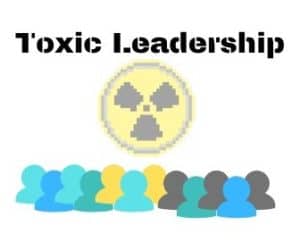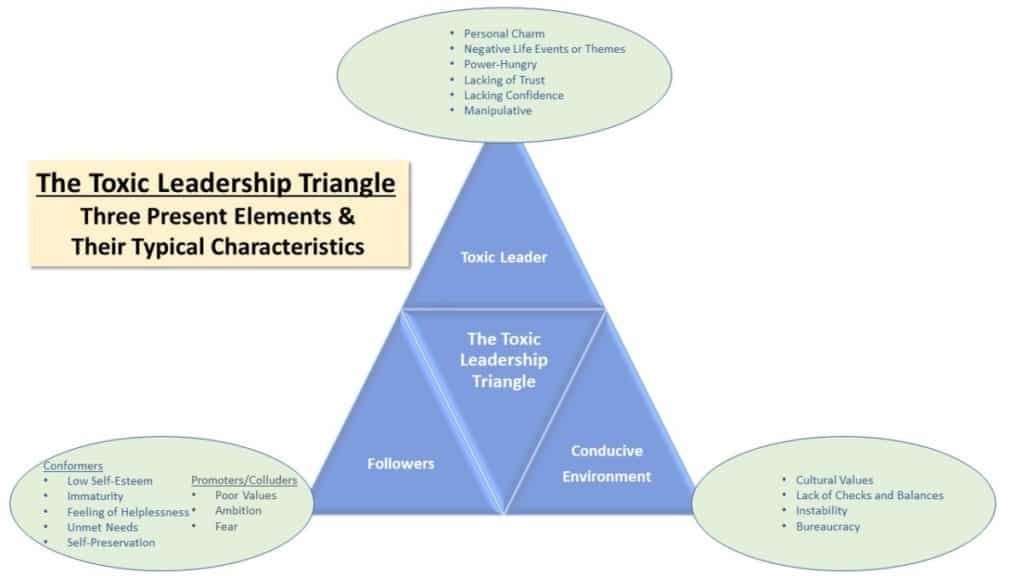
If you’re on this page, there’s a good chance that you’re not here to find out if your own manager is toxic. People who work under toxic leaders already know their situation. They live it regularly, and develop coping skills for dealing with their boss and the environment that’s been created.
But, quite often, due to some of the underlying reasons leaders are dysfunctional, toxic leaders don’t have any idea they have such negative effects on their group. If they do know it, they often will justify their behavior as necessary to reach their goals.
So, let’s take a look at some of the common signs of toxic leadership. This type of leader may exhibit one or a combination of several of the following:
- Incompetence
- Lack of Confidence
- Imposing of Unrealistic Expectations
- Inequity
- Rigidity / Inflexibility
- Erratic Demeanor
- Blaming
- Arrogance
- Lack of Morality
Now, let’s unpack each one and get a little more detail.
Incompetence
A toxic leader may be have a poor understanding of how do complete the tasks assigned to the team. Lack of skills and/or the ability to solve problems within the scope of what’s expected can cause stress in a leader and that leader may develop lack of confidence in their own abilities and fear that superiors and/or their subordinates will notice. This can cause them to want to protect their own job at any cost to their subordinates.
Effective leaders acknowledge their shortcomings in skills or knowledge and put steps in place to become more skilled and knowledgeable.
Lack of confidence
With dysfunctional leaders, lacking confidence often goes hand-in-hand with incompetence. They don’t believe in their own abilities to either perform the tasks of the team, to lead effectively, or both.
It can be exhibited in many different ways, but one way is through constant reminders to the team that he/she is the one in power. They use their power of position to prop up their worth and, in doing so, often devalue their team members. They can rely heavily on legitimate (or positional) power, which is acquired through obtaining the title they hold. They may frequently use it as a weapon. With it, they may use coercive power. Examples of each may sound like this:
Positional or Legitimate Power:
“I’m the boss, and I said to do x,” or “I’m the manager, and what I say goes.”
Coercive Power (frequently used because positional power exists):
“If you don’t do (x), you might want to find another job,” or “I’m going to have to write you up if you don’t complete the task by close of business tomorrow.”
Leaders who lack confidence and like to rely on positional power may remind others of their power through symbols, such as a designated “manager” parking spot. They may take credit where it’s undeserved.
Lack of confidence in themselves often manifests in their inability to relinquish control, empowering their team members to reach results in their own ways. They may come across as leaders who lack trust in their subordinates, but for leaders who doubt their own capabilities, maintaining control is a way to help prove to themselves and others that they know what is taking place.
“Leadership is not about titles, positions, or flow charts. It is about one life influencing another.”
John C. Maxwell
Leaders who lack confidence are typically concerned about how they look to upper management, and, because of that, will not stand up for their team or do things at the expense of their team because of worry over how they may look to their own superiors or peers.
Effective leaders determine the root causes of their insecurities and work on them. They determine ways that they can better their team, and work with their team toward common goals, gaining confidence as the team excels.
Imposing of Unrealistic Expectations
Toxic leaders often have unrealistic expectations of their subordinates. Instead of creating a common understanding of the goals with their team, they determine unilaterally the results that are needed. Sometimes, setting expectations that can’t be met is by design, but either knowingly or unknowingly, the team leader is then able to condemn either individuals or the entire team for falling short of the expected outcome. This takes the onus off of the leader, and places blame on someone other than themselves.
Effective leaders realize that they succeed when their team succeeds. They impose goals that are S.M.A.R.T., (specific, measurable, attainable, realistic, and timed.) They check-in with their team, determining obstacles that can easily be removed; they support.
Inequity
Sometimes, unhealthy leadership is exhibited by inequitable treatment of those people on the team. Favoritism, with no justification, is an example of this. Favoritism, or alienation, can stem from different factors, but it often can be seen as a result of nepotism. (Nepotism, in a work context, is the employing of family members within the same department or company.)
Treating certain individuals in a positive way and others in a negative way without it being relational to work performance can be a sure-fire way to breed contempt and resentment within a group.
Sometimes, the inequity is in the difference in how the leader believes they can act, but the expectations of their team members is different. THEY can come in late and leave early daily, but admonish their subordinates for similar behavior. It’s a “do as I say, not as I do” mentality.
Effective leaders do not “play favorites.” They provide a fair opportunity to succeed, but also are equitable; they take into account individual differences, and while maintaining an even playing field, they re-calibrate where individual difference necessitate it. They hand out praise and the need for improvement equitably.
Rigidity / Inflexibility
Change is inevitable in business, and the ability to change ideas, structure or strategy as a team leader is essential to maintain a healthy team. Many times, toxic leaders are (or come across to the team as) completely inflexible, unadaptable, or unwilling to change. This may be a result of lacking confidence, fear of the appearance of failure or of truly failing, or the need to prove that they are following protocol provided by their own superiors in the company.
Erratic Demeanor
Leaders with erratic dispositions will have subordinates who are constantly on edge. When leaders lack emotional control they may seem happy one minute and upset or angry the next. Employees don’t know what type of emotional environment they’ll be exposed to and it causes stress, dissension and lack of productivity.
Effective leaders know that companies are based on brain-power and actions of people and people are dynamic. They know that they have to be nimble and they roll with change – and expect their team members to deal with change – as business needs require it. They know that inflexibility has no place in a company that wants long-term success and grow to view change as an opportunity.
Blaming
We covered this in the section above about setting unrealistic expectations, but blaming others for bad results can stem from other things, as well. Fault finding frequently comes from someone needing to point out failure in order to make themselves appear and / or feel superior. Accepting responsibility for the problem means acknowledging inferior work, or admitting failure. Pointing the finger at others takes the negative spotlight off of them.
Effective leaders don’t have the need to blame. They’re busy solving problems. While it’s important to them to hold their team members accountable for inadequacies, that is secondary to solving the problem and moving forward. Accountability is approached first from the standpoint of discovering setbacks and then learning how to improve.
Arrogance
Arrogance is, by definition, the exaggerated perception of one’s capabilities or importance.
A leader who is toxic because of their arrogance is typically someone who is on the opposite side of the spectrum as the toxic leader who lacks confidence. This person may have confidence in areas that they shouldn’t, or at least lacks some amount of introspection. This person may truly distrust their subordinates to do as good as job as they themselves would do. They often don’t believe that others have the same abilities. Because of this, they may be quick to criticize. They tend to have poor listening skills because they’re usually caught up in their own thoughts. Since they may not listen well, they either don’t seek feedback or don’t do much with the feedback they receive. Since they believe that they know best, it is typical that they judge situations through their solo lens without gathering different perspectives to base decisions on all information.
Effective leaders are usually perceived as being confident, but not arrogant. They may believe in their own abilities, but also show value in others’ abilities and contributions. They ask questions. They relish feedback, and empower team members to do what’s needed to reach goals. They encourage and guide. They believe that the whole group is more powerful than the sum of its parts. Effective leaders aren’t viewed as arrogant, and to an extent may even sometimes be self-deprecating.
“A boss has the title. A leader has the people.”
Simon Sinek
We talked about legitimate power above, legitimate power being power to comes because of the position held; it’s power that comes from being in control of the people that hold the jobs for which the leader is responsible. Some leader use that power for the good of their team and the company. Some misuse it, attempting to do well by the company at the expense of their team. Some… just use the power as a way to promote self-interests with no concern for their company or team.
Sir John Dalberg-Acton, an English historian, writer, and politician who died in 1869, became famous for saying this about power: “Power tends to corrupt, and absolute power corrupts absolutely.” He’s referring to the control that people have when they have power over people and things, and how power can cause people to act and do things that they otherwise would never do.
This brings us to the last sign of a toxic leader — they may just…
Lack morality
Some leaders do know the difference between right and wrong and choose the immoral route because self-interests are the only thing in their sights. Unless the company itself is unethical, this type of leader is usually eventually flushed out, since total self-interest goes against the nature of a team and would be considered too detrimental to have continued support.
Of course, if “absolute power corrupts absolutely,” in certain leadership roles, the toxic leader continues until overthrown in some way or they die. Well-known historical examples of this might be Adolf Hitler, Idi Amin, Ivan the Terrible, and Joseph Stalin. (Yes, these are all national/military heads in some way, but they serve to make the point.)
Effective leaders are led by their morals. They have a clear sense of right and wrong, and while they sometimes have to make difficult decisions that may hurt feelings, they stand on their solid foundation of what’s just.
Now that we’ve covered the signs of a toxic leader, it’s worth mentioning that a manager’s poor leadership behavior is not the only factor creating the toxic environment. Enter the toxic leadership triangle.
What is the toxic leadership triangle?
It’s a well-researched theory that there are three elements that must be present for toxic leadership to be present: the destructive leader, the followers of this person, and an environment that enables the leader.
This chart explains it a little more fully:

Additional question:
The question arises: Are toxic leaders the same as unethical leaders? The answer? Maybe.
Some leaders just don’t have the skills to head a group in the most productive way. Some are just fearful and lack confidence. It’s arguable that most destructive leaders do try hard to be good at heading up the group, and that blinds them to the results of their behaviors. These folks rationalize as a way of self-protection.
Ethics are moral ideologies that guide how a person behaves. They’re codes of conduct that are developed by an individual or a group or company.
The leaders that engage in practices which go against generally accepted codes of conduct – knowingly or unknowingly – may be considered unethical. If they disregard the value of others, and dishonor or disrespect others in the workplace, they may be considered unethical leaders, irrespective of how they may behave in other aspects of their lives.
“Failing organizations are usually over-managed and under-led.”
Warren Bennis

